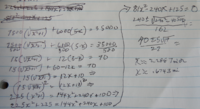Dr.Peterson
Elite Member
- Joined
- Nov 12, 2017
- Messages
- 16,865
It might be good enough for an engineer, but not for a mathematician! In a math problem, unless you are told to approximate, you shouldn't, because the problems are given to allow you to practice the math, not just to solve a practical problem.It is correct but just not correct enough? It was good enough for rock and roll but not Mozart?
Actually, it probably wouldn't be good enough for an engineer, because they care about money. See if you can figure out how many dollars your route would cost, and compare that to $35,000! (On the other hand, the problem is not at all realistic, because the engineer would want to minimize the cost, not just to meet an arbitrary budget.)
Because the distances are not very large compared to 1 mile, your estimate necessarily is not very exact. See MarkFL's answer.

